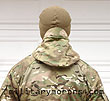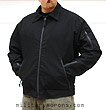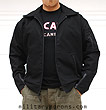Non-Shell Jackets Page 1 2
As a sizing reference: I'm 5'7", 155 lbs (yeah, I'm a little guy), medium build (BDU top medium/regular, BDU pant medium/short), waist 32", chest 43". Keep this in mind when you read my comments with respect to sizing, so you have an idea of how the garments featured below will fit on you. ALL garments in these pages are size Medium, unless stated otherwise.
TO VIEW FULL SIZE IMAGES: USERNAME and PASSWORD are both "mm"
TAD Gear Battle Hoodie (discontinued)
| 9/26/08 - Triple Aught Design (TAD Gear) comes out with new stuff faster than I can keep up. The Battle Hoodie was designed as a cool/cold temperature, arid-desert warfare hooded jacket. It's a specialized jacket, and was produced in response to very specific requests for a quiet, non-melting, insulated garment for dry environments. TAD Gear was asked to design a garment that would be tasked for the colder months at higher altitudes in Afghanistan and Iraq. It had to be no-melt and was to be used in dry/arid environments, so a cotton blend for the outer fabric was chosen. Warmth was desired, so it is fully lined with a cotton liner. The Battle Hoodie is the garment that resulted from this criteria. It's reminiscent of a combat smock, but lined instead of just a shell. It also reminds me somewhat of the old M-65 field jacket, but of a much more modern design and lighter in weight. A non water-resistant, cotton/cotton blend, insulated jacket seems like a narrowly focused garment, given the variety of today's soft and hardshell jackets, and the tendancy towards layering. But when you look at the popularity of similar jackets in the civilian arena (Carhartt cotton duck insulated work jackets come to mind), you realize that it's actually a practical choice for an everyday, cool/cold weather jacket if it's dry and windy. Overall Features
Sizing and fit - From the way it fits, the Battle Hoodie is sized more as a stand-alone jacket than one intended to be worn over additional layers. As a Medium kinda guy at 5' 7" and 155-160 lbs, the Medium size fits me just about perfect with a little bit of room all around, but the added volume of the cotton lining inside doesn't leave room for anything but a thin base layer or short-sleeved t-shirt. I wouldn't wear it with anything bulky underneath. The sleeves are cut longer to prevent the cuffs from creeping up the fore arms when the arms are reached out or up, so they reach down to my fingertips. The bottom of the Battle Hoodie is longer than the Stealth Hoodie, and covers my butt. There are a couple of things which I felt could be
improved when it comes to fit: General Notes - TAD envisioned the Battle Hoodie to be their version of a smock, but more modern and updated. But since it's lined, it feels more like a field jacket, or a smock worn over a comfy sweatshirt (or actually, a flannel pajama top). In other words, warm and comfortable. It's best suited for temperatures 70° and below, in my own estimation. It's definitely not a wet weather jacket, being designed for cool, dry climates. Abrasion resistance and durability will be similar to or better than a set of ripstop BDUs; the lining provides some padding and the elbow and shoulder cordura panels will be very wear resistant in those areas. It's also very wind resistant - I tested this out by going on a chilly, early morning ride on my motorcycle. When the sun goes down and a cool breeze starts blowing, the lined hood is especially welcome. Not normally found on cotton jackets like this are the pit zips, which really do make a difference in ventilation. Some might argue that pit zips are necessary only for less breathable garments like hardshells and some soft shells, but I like having the ability to vent a large amount of warm air without having to open the main zipper or rely 'breathability'. The Battle Hoodie functions well as a casual jacket (in the solid colours, if the MultiCam is a bit much for around the town wear) for everyday use in cool and dry weather, and can take the place of a heavy sweatshirt while providing wind resistance and of course, more utility with all its pockets. It can also be considered a field jacket or insulated smock. For a seemingly niche product designed for a narrow task (in the military or contractor role), I think that it's a pretty versatile jacket well suited for general purpose, everyday casual outerwear. The fact that it's a damn good-looking jacket doesn't hurt either.
|
TAD Gear Limited Edition Striker Leather Flight Jacket
| 12/4/07 - Just like they did with their Legionnaire Classic pants and Garage Jacket, TAD Gear has yet again given another classic design the TAD Gear treatment. The Striker Leather flight Jacket is patterned after the German military (Bundeswehr) issue flight jacket (flieger jacken), which is issued to pilots in the Air Force (Luftwaffe), Navy (Marine) and Army (Heer). It's a superb example of current issue military style and design that's versatile enough for every day wear just about anywhere you can think of. Patrick at TAD Gear bought his first current issue Luftwaffe jacket back in 1987, and really liked the design as it was unlike anything else on the market. The cut was designed for every day wear, like a baseball or letterman jacket. It was a more casual fit, and less restrictive than a close-fitting motorcycle jacket, but still a great military/”industrial” function-first type design. He had been wanting to do a higher quality version for a long time, so finally, the Striker jacket was born. TAD Gear's website states that "Our Striker Flight Jacket is perfect for everyday street wear, adventure travel, motorcycling, pilots, 4 wheeling, and anyone looking for a totally distinct, and excellently made EDC leather jacket. Looks great with your favorite pair of jeans, khakis, or cargo pants. From the first moment you put it on, you'll feel like you're wearing an old broken-in favorite." I'm inclined to agree. Material - The Striker jacket is cut on the exact same pattern as the current issue German Pilot and Air Crew Flight Jackets, and custom made in one of the finest bespoke (tailored) leather shops in the USA, specializing in Motorcycle Police and Competition Racing leathers. TAD chose select American Free Range Goatskins for their superior strength to weight ratio. Goatskin is a strong, supple leather with a proven track record for durability and its long-lasting properties. Compared to cowhide, it has the same durability for less weight compared to cowhide and even more comfort from their supple characteristics. The Striker jacket is constructed out of 3 oz goatskin. Many foreign-made leather jackets and coats are made of 1 oz leather. It's determined by taking a 1 ft x 1 ft sample cut from the finished hide and weighing it, and comparing that weight to the thickness. 2.5 oz or 3 oz leather is considered the optimum leather weight for flight jackets, providing a good balance between durability and suppleness. Each goatskin hide is unique and displays distinct grains & textures from free range goats. Instead of the gray colour that the German flight jackets are made of, the TAD chose a unique colour they've dubbed as 'Terra Green'. It's difficult to pin down as it looks different depending on the lighting conditions. It looks more brown under yellowish light (in the late afternoon light above, for example) and greenish-brown under artificial (fluorescent) light and overcast days in the photos below. Whatever it is, though, it's a smart-looking shade that goes well with just about any other colour. In the far right photo below, the Striker is shown right next to a dark brown leather A2 flight jacket.
The main features of the Striker Jacket are as follows (size 42 shown):
The Striker jacket is cut right at "flight jacket length" - just below the waist. The fit is relaxed (on me); not tight at all, but not baggy either. As mentioned above, it fits very much like a letterman jacket. There's enough room to fit a sweatshirt or the TAD Scout Hoodie under the jacket for added warmth. The Striker has no insulation other than the lining. TAD spared no expense on the Striker, and it shows. The materials, stitching and workmanship (even inside the jacket and pockets) are simply excellent. The leather is thick, yet supple with an attractive grain and that scent. I don't find it heavy or too warm; I find it very comfortable for temperatures around 70°F and below. It's ideal for cool or windy conditions, as leather stops the wind completely, yet remains breathable. The collar can be worn open or zipped up to form a turtleneck. My only other non-motorcycling leather jacket is a 17-year old Avirex "AVG" A2, which is still going strong and a nice jacket (even though the Avirex A2 is only a loose approximation of the original A2 design, which I didn't know back then). I tended to wear it less over the years as it became such a common design, with cheap knockoff 'bomber jackets' sported everywhere. The Striker/German flight jacket style is much less common than the A2 or G1, and is classy, stylish and functional. Overall, it's a more streamlined jacket without the shoulder epaulets and flap pockets. This jacket will not go out of style anytime soon. The Terra Green shade further adds to the uniqueness and distinctive look of the Striker. I've been wearing it all over the place - every day wear to work, around town, on my motorcycle, and have found it to be a very comfortable and versatile jacket. The colour also goes well with the pants I wear most often; OD green, khaki and jeans. While I love my synthetic jackets made of the latest high-performance rain-shedding breathable membrane materials, they just don't have the character of a well worn classic leather jacket. Shown below is the Striker Jacket with MM graphic designed and custom printed by Andrew Bawidamann. This is the same graphic as found on the MM T-shirt.
|
| 9/9/07 - So the story goes, the "Garage Jacket" had its origins as a simply-styled jacket worn by mechanics working on cars - both as protection from the cold concrete floor of the garage and when it was chilly at the drag strip. This "working-man's" jacket has become a classic American garment used for casual outerwear, no longer worn only by gear-heads and hot-rodders but by anyone appreciating its simple and practical style and cut. For the debut of their first dedicated urban street wear jacket, TAD Gear has taken this classic American garment and "supercharged" it without changing its familiar, smart, straight lines. As you can see from the photos below, the TAD Gear V8 Garage Jacket is a great looking jacket, but doesn't look too unusual at first glance. TAD took the subtle route with the V8, infusing it with neat TAD features that are more covert than overt. The V8 is made from rugged 100% cotton canvas, and only available in True Black. It's a substantial fabric - but not so thick as to be stiff. What sets the V8 fabric apart from other cotton jackets is that it's Epic Nextec treated, which encapsulates the fibers in silicone. This produces a highly water-resistant, windproof, breathable and washable cotton. Water beads up and doesn't penetrate the fabric, and it's also much quicker drying than standard cotton as the fibers don't want to hold water. I took the photo above one and a half hours after putting the water on the jacket. After I shook the water off and felt the fabric, it was completely dry with no 'wetting out'. In my experience with other Epic-treated fabrics, I've found that they are highly water resistant as advertized, but not water proof, so take note of that distinction. The V8 is not intended to replace rain gear, but it will defintely keep you drier for longer than a regular jacket.
Here's a rundown of the features on the V8 Garage Jacket (medium size shown):
One thing I've really begun to appreciate with just about all of TAD Gear's clothing is the organization offered by 'pockets within pockets'. So much so that I miss those features when I wear 'normal' pants or jackets. I like being able to segregate my keys, cell phone, pager, sunglass case and change instead of putting them together to collect at the bottom of my pockets. Having separate compartments also keeps movement of items within the pockets to a minimum when running around. The V8 offers the same kind of organization in a more subtle manner and I'm sure will be popular with those wanting TAD's features in a non-tactical looking jacket. I'd rate V8 as a light-medium to medium jacket, as far as usage in cool weather. For colder weather, TAD showed the V8 layered over their Scout Hoodie, which needs an outer layer if there's a wind blowing. The V8 is sized more generously than TAD's stealth hoodies, and cut such that the lightweight Scout Hoodie layers underneath without feeling bulky, and looks good when worn as a combination. The V8 is a great urban-casual jacket with a Classic American look, but with the added bonus of modern features and fabric technology.
|
ATTENTION! PLEASE DO NOT LINK DIRECTLY TO MY IMAGES
-
IT RESULTS IN MY BANDWIDTH ALLOCATIONS BEING EXCEEDED,
AND MY PAGES GO DOWN. THANKS!
/ . PLEASE
OBSERVE AND RESPECT OUR COPYRIGHT! . /
©opyright by MilitaryMorons.com. All Rights Reserved. Reproduction, Duplication,
Distribution Strictly Prohibited.
Unless mentioned otherwise, content and images are the
property of militarymorons.com and are not in the public domain.
They are not to be used without
permission. Please Contact
me for permission to use any images or content herein.



































































